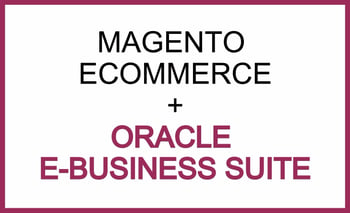
 A Magento and ERP integration project can streamline business operations, more powerfully leverage back office data, and solve business challenges through technology. Integrating Magento with Oracle E-Business Suite (EBS) specifically will enable your organization to become more efficient as it facilitates many key processes.
A Magento and ERP integration project can streamline business operations, more powerfully leverage back office data, and solve business challenges through technology. Integrating Magento with Oracle E-Business Suite (EBS) specifically will enable your organization to become more efficient as it facilitates many key processes.
Whether your organization is looking to eliminate redundant or duplicate data, automate data exchanges between systems, reduce the cost of sales transactions, or all of the above, integrating your Magento and EBS environments can achieve those goals.
As is the case with any integration project, prioritizing types of data you need to access and share between systems will help you maximize the benefits of connecting Magento eCommerce and Oracle EBS.
Every project is different and the specifics of each technology will dictate the details of an integration, but our team follows six key steps for a successful integration for every project we do. These steps help ensure that the best possible solution is applied.
When beginning a Magento eCommerce and ERP integration, you first need to ask yourself a few questions: What is the site intended to do? Is it intended to primarily increase revenue, decrease costs, or improve customer satisfaction? Rank these in order of importance, with only one ranked as most important.
Get the sales team on board. Make sure the sales team understands what role the online site will play in the company and how they can leverage the site for success. An eCommerce site can be a valuable tool in your sales teams’ arsenal to effectively and efficiently meet your customers’ needs.
An eCommerce project, especially in a B2B environment, will touch almost every part of your organization: Sales and Marketing, Operations, Finance, and especially IT. There must be a champion for this endeavor within your organization, someone who will help to drive the project through to launch and ensure that it gets the TLC it deserves thereafter.
Data is the lifeblood of an eCommerce engine, and the data needed for an integration project typically already exists in the ERP. This makes it critical to set a strategy around the data integration. It is crucial to determine where each data element should be stored and which system owns the data.
After it’s determined whether the eCommerce or ERP system owns each piece of data, consider the business logic required to process an eCommerce order. ECommerce systems typically include functionality that is duplicated in the ERP, such as item pricing, taxing, and order processing. In considering these redundancies, look to keep a business function within the system that is best suited for processing that function.
There are several integration options available, including a simple FTP process, an MQ Series, and Web (Business) Services. It’s often beneficial to use an integration methodology that is already being used, but it may make sense to change to a new technology. When deciding on which methodology to use, you need to consider the initial programming needs as well as ongoing support. Our team regularly turns to our Ten Points of Integration strategy for success.
To see these steps in action, click here to read more about a recent Magento eCommerce and Oracle EBS integration project.
Lorem ipsum dolor sit amet, consectetur adipiscing elit

For the past two decades, we've made it our business to help you work smarter. From commerce challenges to ERP customizations, we support the power of your big ideas by helping you work more strategically, more intuitively, and more efficiently.
2658 Scranton Road, Suite 3
Cleveland, Ohio 44113
216.369.3600
No Comments Yet
Let us know what you think